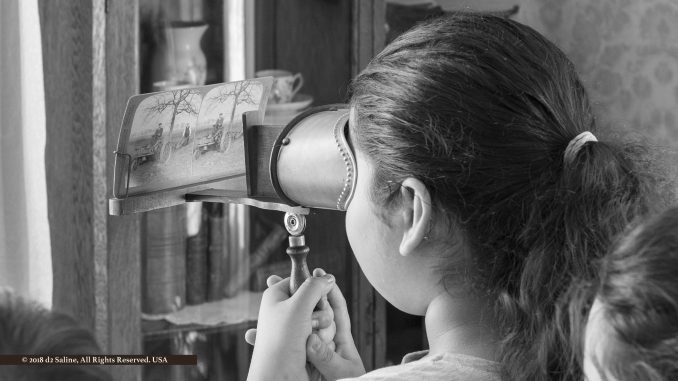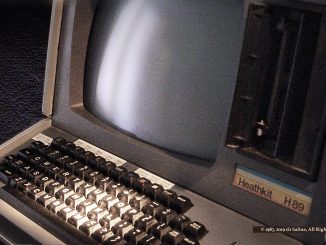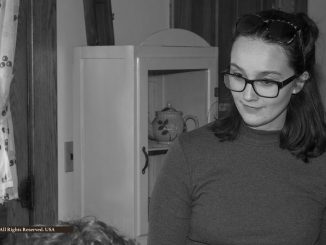
How long has stereoscopic photography been available to everyday consumers? [1]
The cliché image is that of a more seriously dressed movie theater audience, men wearing jackets and ties, women in dresses, focused with rapt attention on an unseen screen before them — wearing cardboard glasses. When color version of these images from the 1950s can be found it’s obvious that one eye sees through a green lens, the other red. This allowed people to look at two images superimposed on the same screen, each eye seeing just one of those images — differing in capture angle by the average interocular distance. [2,3]
Voilà! This is what is generally known as 3D. And so long as these two only slightly different looks at the same subject could be made available in capture, then subsequently viewed by each of your eyes simultaneously, 3D images could be produced as prints, slides, and even movies. It can be done with animations, too. [4]
Locally, Emagine Theatre regularly offers showings of 3D version of first run movies, including Mission: Impossible – Fallout and Jurassic World: Fallen Kingdom. [5,6]
The latest surge in mainstream interest for stereo movies is widely thought to have come from the James Cameron movie Avatar in 2009. Before that, Baby Boomers will likely be stumped until they remember Jaws 3-D from the 1980s. Another three decades before that, House of Wax, starring the late Vincent Price — in color. Horror seemed an ideal genre for a technology where images seemed unbounded by the constraints of a screen, capable of reaching out from it to shock and amaze all who sat before it. [7,8,9]
At home it was a different story. Remember View-Master, which first appeared in 1939. Distinguished by seven image pairs mounted on cardboard discs, handheld devices were used to restrict each of the individual’s eye to seeing just one or the other in order to achieve the effect. [10,11,12]
Initially it was intended that the View-Master be an educational tool, primarily aimed at adults, but as time developed the appeal of the View-Master soon spread to other areas, one of the more notable being children’s entertainment.
The US Military were keen advocates of the View-Master and had specially commissioned sets of reels produced to aid with artillery spotting and aircraft identification during World War II. They purchased many millions of reels for this purpose, together with 10’s of thousands of Model B viewers.
That takes this story reasonably close to the period in which the Rentschler Farm Museum is presented today. But the origins of stereo photography date back much further. In fact, the Smithsonian has traced it to the late 1830s and the beginnings of photography itself. Stacy Webb, Director of the 3D Center of Art & Photography in Portland Oregon, cites the “stereocard,” sold door-to-door “just like encyclopedias and vacuum cleaners.” One such example he mentioned was called “Tour of the World.” [13,14,15,16]
The stereograph, or stereo view, consisted of a double set of paper prints mounted on card stock to be viewed through a stereoscope to produce a three dimensional image. They became a popular photographic medium in Europe in the mid-1800s, and through mass production methods became widely distributed in the United States by the 1880s. Stereographs reached their peak of popular distribution in the years 1902-1935 through the business efforts of such companies as the Keystone View Company and Underwood & Underwood. [17]
One of the highlights of the “Living History Program” elementary school field trip tours of Rentschler Farm Museum was the opportunity for visitors to actually view cards such as these in the farmhouse parlor. State-of-the-art entertainment was in use in the City of Saline here. [18]
A fitting harbinger of 3D offerings a hundred years later and a five-minute walk way at Emagine Theatre.
References
- “stereoscopy” Merriam-Webster.
- Photograph by JR Eyerman (November 26, 1952) Time & Life Pictures / Getty Images.
- Emagine Entertainment (showtimes).
- “The View-Master slides of our youth were beautiful works of art” (June 14, 2016) MeTV.
- “Mission: Impossible – Fallout (2018)” IMDb.
- “Jurassic World: Fallen Kingdom (2018)” IMDb.
- “Avatar (2009)” IMDb.
- “Jaws 3-D (1983)” IMDb.
- “House of Wax (1953)” IMDb.
- “View-Master” The Strong: National Toy Hall of Fame.
- “A visual history of Mattel’s View-Master” Edgar Alvarez (February 13, 2015) engadget.
- “View-Master History” 20th Century Stereo Viewers.
- “How Did Christmas Feel in a Rural Saline Home During the 1930s?” Janet Deaton (December 7, 2015) Saline Journal.
- “The Long History of 3D Photography” Boaz Frankel, Smithsonian.
- “A Guide to the Keystone View Company ‘Tour of the World’ Stereographs, ca 1892-1933” Briscoe Center for American History, The University of Texas at Austin.
- “Antique and Vintage Stereoview Photographs” Collectors Weekly.
- “Stereocard Collection” University of Washington.
- “Imagine Seeing Rentschler Farm Museum Through The Eyes Of A Child During Your Next Visit, Part 3” Dell Deaton (July 20, 2018) Saline Journal.



